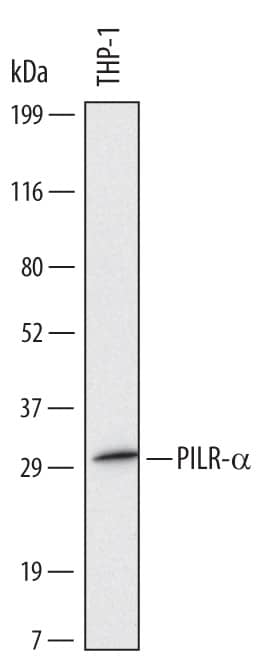Human PILR-alpha Antibody
R&D Systems, part of Bio-Techne | Catalog # MAB6484

Key Product Details
Species Reactivity
Applications
Label
Antibody Source
Product Specifications
Immunogen
Gln20-Thr196 (predicted)
Accession # Q9UKJ1
Specificity
Clonality
Host
Isotype
Scientific Data Images for Human PILR-alpha Antibody
Detection of Human PILR‑ alpha by Western Blot.
Western blot shows lysates of THP-1 human acute monocytic leukemia cell line. PVDF Membrane was probed with 2 µg/mL of Human PILR-a Monoclonal Antibody (Catalog # MAB6484) followed by HRP-conjugated Anti-Mouse IgG Secondary Antibody (Catalog # HAF007). A specific band was detected for PILR-a at approximately 30 kDa (as indicated). This experiment was conducted under reducing conditions and using Immunoblot Buffer Group 1.Applications for Human PILR-alpha Antibody
Western Blot
Sample: THP‑1 human acute monocytic leukemia cell line
Formulation, Preparation, and Storage
Purification
Reconstitution
Formulation
Shipping
Stability & Storage
- 12 months from date of receipt, -20 to -70 °C as supplied.
- 1 month, 2 to 8 °C under sterile conditions after reconstitution.
- 6 months, -20 to -70 °C under sterile conditions after reconstitution.
Background: PILR-alpha
Paired immunoglobulin-like type 2 receptor alpha (PILRa; also inhibitory receptor PILR-alpha) are 44-50 kDa paired receptors that consist of highly related activating and inhibitory receptors, and are widely involved in the regulation of the immune system. PILR-alpha is thought to act as a cellular signaling inhibitory receptor by recruiting cytoplasmic phosphatases like PTPN6/SHP-1 and PTPN11/SHP-2 via their SH2 domains that block signal transduction through dephosphorylation of signaling molecules. Human PILR-alpha is synthesized as a 303 amino acid (aa) precursor that contains a 19 aa signal sequence, a 178 aa extracellular domain (ECD), a 21 aa transmembrane segment, and an 85 aa cytoplasmic domain. The ECD contains one Ig-like V-type domain and one potential site for N-linked glycosylation. The cytoplasmic domain contains two ITIM motifs (aa 267-272 and 296-301). Alternate splicing generates multiple shorter isoforms. One is TM and possesses a 35 aa substitution for aa 264-303, while others are soluble, and show a deletion of aa 152-224 that may be coupled to the 35 aa substitution noted above, or simply exhibit a 24 aa substitution for aa 152-303. Mature human PILR-alpha is 45% aa identical to mature mouse PILR-alpha. PILR-alpha is predominantly detected in hemopoietic tissues and is expressed in monocytes, macrophages, and granulocytes, but not lymphocytes. It is also strongly expressed by dendritic cells. PILR-alpha interacts with herpes simplex 1 glycoprotein B and functions as an entry coreceptor for this virus.
Long Name
Alternate Names
Gene Symbol
UniProt
Additional PILR-alpha Products
Product Documents for Human PILR-alpha Antibody
Product Specific Notices for Human PILR-alpha Antibody
For research use only
